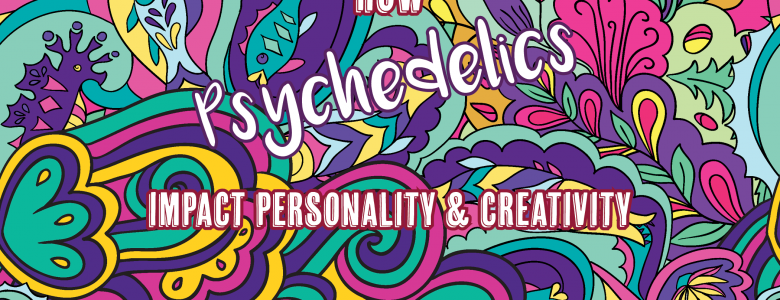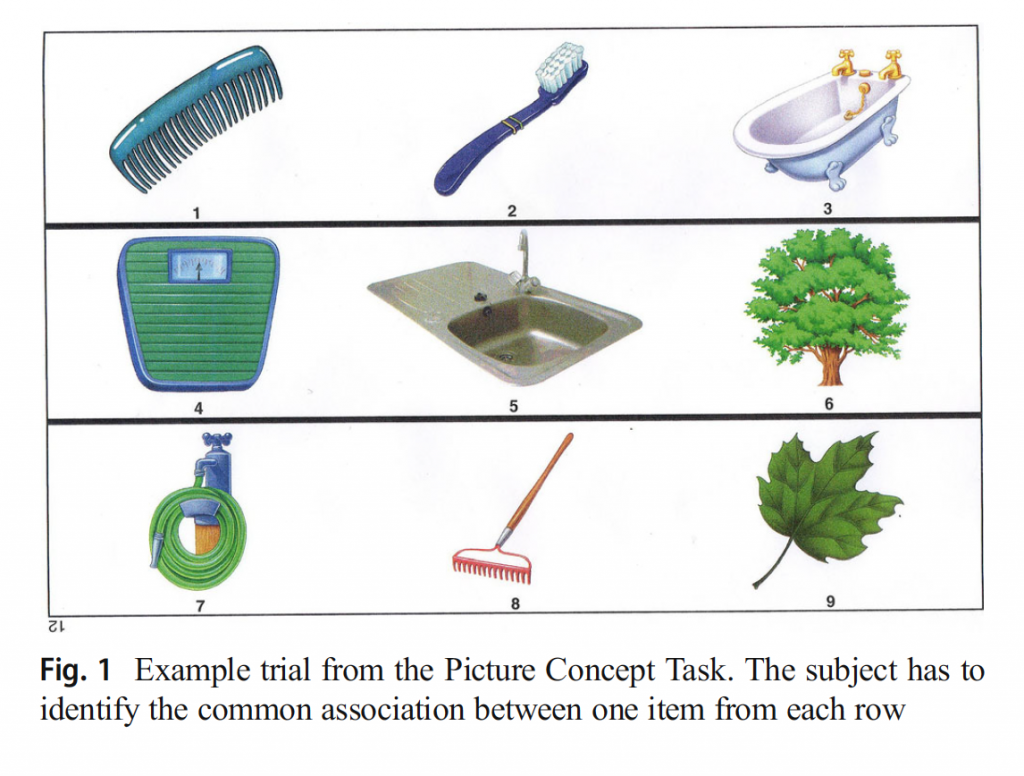April 15, 2020
How Psychedelics Impact Personality and Creativity

By: burgundy bug
How Psychedelics Impact Personality & Creativity
Source: The Burgundy Zine
It only takes a few milligrams of a naturally occurring compound – or even a just few micrograms on a sliver of paper – to open your mind to a vibrant swirl of creativity and long-lasting personality changes.
While psychedelics have shown efficacy in treating various mental health conditions including anxiety, treatment-resistant depression, and post-traumatic stress disorder, they also carry the potential to help researchers further understand the interplay between various brain networks, says a 2018 Medical Hypothesis study.
A Bit of Context…
Throughout many studies referenced in this article, researchers employ a revised version of the NEO Personality Inventory, a 240-item test that evaluates neuroticism, extraversion, openness, agreeableness, and conscientiousness, which are associated with the following traits:
- Neuroticism: anxiety, anger, hostility, depression, self-consciousness, impulsiveness, vulnerability
- Extraversion: warmth, gregariousness, assertiveness, activity, excitement seeking, positive emotions
- Openness: fantasy, aesthetics, feelings, actions, ideas, values
- Agreeableness: trust, straightforwardness, altruism, compliance, modesty, tender-mindedness
- Conscientiousness: competence, order, dutifulness, achievement striving, self-discipline, deliberation
The NEO-PI-R consists of a series of personality questions that can be answered on a scale from “Very Inaccurate” to “Very Accurate,” as well as visual, linguistic, and mathematical brain teasers.
You can take the NEO-PI-R here for free.
Psychedelics and Long-Lasting Personality Changes
“Personality is known to be relatively stable throughout adulthood. Nevertheless, it has been shown that major life events, including experiences engendered by psychedelic drugs, can have an enduring impact on some core facets of personality.”
LSD-induced Entropic Brain Activity Predicts Subsequent Personality Change | Human Brain Mapping
Researchers used a revised NEO-PI-R to evaluate the traits of 19 healthy adults prior to taking 75µg of LSD and a placebo, then did a follow-up NEO-PI-R with the participants two weeks later in a 2016 Human Brain Mapping study.
Throughout the study, researchers also used an fMRI scan to monitor their brain activity during resting states with and without ambient music.
The fMRI data showed LSD increased connectivity patterns, exerting its effects in 11 out of 17 possible functional systems throughout the brain, including sensory networks as well as the default mode network.
Read: The Default Mode Network: The Center of You
The Burgundy Zine
When comparing the original NEO-PI-R scores to the two-week follow-up, researchers found a significant change in openness among participants who were administered LSD.
“Those who had the highest enhancement of ego-dissolution during and after listening to music and the most prominent increases in brain entropy [connectivity patterns] were also those who demonstrated the greatest increases in openness,” the study states.
Although it’s unclear how LSD exhibits lasting personality effects, the researchers suggest it has a neurobiological basis. They also ponder whether there are physical changes in brain structure following an LSD session, which warrants further research.
Psychologically, profound experiences can lead individuals to reassess themselves and their behavior – and 67 percent of individuals rank psychedelic sessions among the top five most meaningful experiences of their life, “comparing it to the birth of their first child,” the study adds.
“In a similar way, psychedelics may serve as an ‘existential shock’ therapy, confronting individuals with the illusory nature of their self or ego and its attachments,” the study says. “If handled with proper care, such experiences may have a unique role to play in psychotherapy, promoting insights and self-actualization, as detailed in certain schools of psychology and religious philosophy.”
In a 2018 Acta Psychiatrica Scandinavica study, researchers carried out a similar experiment with psilocybin, the compound found in “magic mushrooms.”
Twenty participants with moderate to severe treatment-resistant depression were given 10mg and 25mg of psilocybin during sessions that were one week apart. Prior to taking psilocybin, the participants completed the NEO-PI-R and completed it again during a three month follow-up.
Not only did researchers find an increase in openness during the follow-up, but participants’ neuroticism scores had significantly decreased. They also observed an increase in extraversion and conscientiousness.
“The degree of insightfulness experienced during the focal 25mg psilocybin session was significantly associated with a reduction in neuroticism, as well as an increase in extraversion,” the study explains.
In a “naturalistic survey” referenced in the study, the results showed increases in openness following a session were the same among depressed and non-depressed individuals, whereas only the depressed individuals expressed changes in neuroticism – the NEO-PI-R factor associated with anxiety, depression, self-consciousness, and vulnerability.
Another 2018 Psychopharmacology study on how psilocybin affects personality in those with treatment-resistant depression asked participants to self-report their symptoms using the QIDS-SR16 prior to 10mg and 25mg psilocybin sessions and six months after the fact.
“QIDS-SR16 scores were significantly reduced at all six post-treatment time points with the maximum effect size at 5 weeks,” the study reports. “Of the 19 patients who completed all assessments, all showed some reduction in depression severity at one week and these were sustained in the majority for three to five weeks.”
Additionally, the psilocybin was well-tolerated among participants. There was only one individual who had become uncommunicative during the peak of the 25mg dose, which they later said had been “blissful and beneficial but also overwhelming,” the study explains.
Other side effects included feelings of anxiety that only lasted for a few minutes and headaches that lasted for one to two days. Five participants reported short periods of nausea, but none vomitted.
“As with all our previous work with this compound, there were no reported cases of so-called flashbacks or persisting perceptual changes.”
Psilocybin With Psychological Support for Treatment-Resistant Depression: Six-Month Follow-Up | Psychopharmacology
Suicidal feelings and thoughts had significantly reduced among the participants one to two weeks after the psilocybin session… So did sexual dysfunction scores.
Although their results are in line with previous trials carried out by the same researchers and many others, the study stresses the importance of reinforcing the safety of psilocybin treatment and how it could be carried out (for example, sessions within the presence of a trained professional) before it’s implemented in a clinical setting.
Psychedelics and Creativity
“Creativity, a multi-component construct includes flexible divergent and rigid convergent thinking,” says a 2018 Medical Hypotheses study. “Psychedelic drugs like psilocybin can enhance creativity and affect state of mind (mood, empathy, openness).”
Divergent thinking:
Source: Divergent Thinking | Merriam-Webster
“creative thinking that may follow many lines of thought and tends to generate new and original solutions to problems”
Before diving into the impact psychedelics have on creativity, the author K.P.C. Kuypers details the three core brain networks involved in creative states: the central executive network, the default mode network, and the salience network.
The central executive network “is engaged in high-order cognitive and attentional control,” Kuypers explains. Whereas the default mode network is involved in self-referential processing and the salience network directs attention to “events occurring outside of the body and internal consciousness” depending on which is more important at the time.
Dopamine, the “feel-good” hormone, also plays a role in creativity. Too much dopamine can lead to impaired divergent thinking, but medium to high levels of dopamine are associated with more flexible thinking.
Psychedelics have demonstrated positive effects on mood and increases to openness as well as empathy, Kyupers continues. It’s theorized that positive moods allow innovative ideas to flow more freely. Furthermore, openness and empathy are linked to enhanced divergent thinking.
During a psychedelic session, there’s a decrease in default mode network activity, which may facilitate more flexible and creative thinking, she explains. But it’s worth noting that creativity and openness are associated with increased functional connectivity within the default mode network – perhaps allowing for more creative, flexible thoughts after a session.
On the other hand, a 2020 NeuroImage study says enhanced creativity during a psychedelic session may be more subjective in comparison to actual creative ability.
Instead, the researchers point to the “relatively unconstrained cognition and hyper-associative” psychedelic state – which is similar to dreaming or lucid dreaming – that may allow for more “wide-ranging novel and ‘out of the box’ ideas.”
“Importantly, we contend that the entirety of a psychedelic state can be conceived as a mode of creative generation and that evaluations of usefulness of the generated ideas should take place when in a non-drug state,” the study says.
When intelligence, divergent and convergent thinking were put to the test under the influence of microdosed psychedelics in a 2018 Psychopharmacology study, researchers observed an increase in both modes of thinking but intelligence remained the same.
The study took place at a microdosing event organized by the Dutch Psychedelic society and the truffles were dosed to participants based on their body weight.
A Picture Concept Task was used to measure convergent thinking, the Alternate Uses Task for divergent thinking, and the Raven’s Progressive Matrices Task for intelligence. All three tests were taken prior to ingesting the truffles and once again during the psychedelic session.
“Fig. 1 Example trial from the Picture Concept Task. The subject has to identify the common association between one item from each row.”
Source: Exploring the Effect of Microdosing Psychedelics on Creativity in an Open-Label Natural Setting | Psychopharmacology
During the Picture Concept Task, participants were shown multiple images asked to find a common association between them.
The Alternate Uses Task presented participants with a variety of household items and asked them to brainstorm as many possible uses for the items within a certain period of time.
Lastly, the Raven’s Progressive Matrices Task showed participants a series of images where one part of the pattern was always missing. Participants then had to figure out what the missing piece of the pattern would look like.
“Performance on the Picture Concept Task (number of correct responses) was significantly higher in the second time than the first session, showing an improvement of convergent thinking,” the study reports.
As for the Alternate Uses Task, the researchers observed a significant increase in fluency during the test taken after consuming truffles. There were also partial increases in flexibility and originality of the participants’ answers.
Different versions of the Picture Concept Task were used, so it’s not possible the participants would’ve remembered their previous answers.
It’s also unlikely for a “learning-effect” to have occurred during the Alternate Uses Task, as other research referenced in the study didn’t show any positive influences on scores of individuals who repeatedly took the test (and weren’t under the influence of any substances).
However, it’s possible the participants may have subconsciously expected to do better while under the influence of truffles, and so those expectations could’ve played out, the study admits.
But if it were an expectation effect, one would assume the performance on all three tests or simply just one test would’ve improved, which doesn’t align with the outcome of the study.
“Notwithstanding these caveats, the outcome pattern of the present study is consistent with the idea that microdosing psychedelic substances improve both divergent and convergent thinking,” the study concludes.
In Conclusion
Psychedelic portrait of a hippie woman with colorful hair and an all seeing eye on her hand
Source: Adobe Stock
Psychedelics can open the user up to a whole new perspective that allows creativity to flourish, and these sessions can have positive impacts on personality traits that last for months – perhaps even longer.
Exciting as it may seem for a Joe Schmoe or Jane Doe, it’s tenfold for researchers who see these results as an avenue for developing a short-term treatment applicable to a variety of mental health conditions that have a lasting positive outcome for patients.
These findings also present opportunities to further explore various brain networks and how they work together with one another.
Interested in having content featured in an upcoming blog post or issue of The Burgundy Zine? Head on over to the submissions page!
For all other inquiries, please fulfill a contact form.




